New UK dealership BD-Audio, based in the lovely UK Midlands town of Malvern and headed up by Jack Durant, has taken on the Chinese designed & manufactured Ming Da brand of valve-based electronics.
Looking at the pricing of the equipment, many folk might quite understandably do a double-take – perceived value is extremely competitive, especially at the lower end of the price range. When the kit is seen ‘in the flesh’ the feeling of great value for money is further enhanced – these are lovely items to behold. Production quality seems very high and the aesthetic design is distinctive and attractive. Warranty is 2 years on the equipment and an unusually generous 1 year on the valves.
Jack paid a visit to my humble abode a few days ago and brought with him a selection of Ming Da kit for me to audition and review.
I listened to all of the equipment with the stock Chinese valves, and although I have no reason to think they are poor, you will certainly be able to obtain different sonic flavours with a bit of ‘valve rolling’.
Remarkably ugly valve cages are provided to meet CE regulations; these are easily removed for when they are not required to keep inquiring small hands or paws at bay!
Ming Da MC-7SE pre-amp
With a current UK retail price of £1520 this remote controlled (volume level and mute) stereo valve pre-amp is a lovely thing for an audiophile to behold.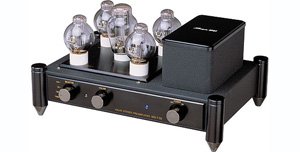
4 pairs of stereo RCA inputs and 2 pairs of RCA outputs but no fixed level output (“tape”) is available. The circuit includes five valves (tubes), four of these valves are the 6SN7 type, the other, a rectifier, is a 5U4G.
The remote controlled mute function is a little unusual – rather than the typical electronic on/off mute, here the volume control just winds itself down to zero.
This pre-amp has a very, very distinctive sound – I’ve not heard a pre-amp quite like this before.
A few descriptive words leapt immediately to mind after just a very brief listen – bold, precise, solid, presence, defined, controlled, powerful, lucid. Bass was deep, powerful and amazingly well controlled. Mids were very boldly presented, treble was delineated with absolute precision. No smear, no splash, no vagueness at all.
You probably know if you’d love this pre-amp already!
I can imagine many music lovers and audiophiles reaching for their wallets after 30 seconds of hearing what this pre-amp can do. And I don’t expect they’d regret that seemingly impetuous decision.
‘Big Music’ – whether large orchestral (Mahler 3rd and Shostakovich 10th symphonies) or The Buggles (Age of Plastic) or Eddy Louis’ (Blues for Klook) – was rendered very powerfully, and with utmost precision and control, and with no screech or splash at all even at their considerable raunchiest.
But there is delicacy, too, for smaller scale music and huge amounts of finely resolved detail.
Very well defined and focussed, the sound quality is very explicit whatever the musical genre or volume level asked of it. This isn’t a component which hides its abilities – I find myself using the word ‘very’ a lot when writing this review!
It sounds fabulous doesn’t it. And so it is, in many ways. A word of warning, though. To my ears it does need careful partnering to avoid the sound getting too tight and controlled. I started off using my Resolution Audio CD50 CD player as source, and to be honest it wasn’t the best match. The CD50 has broadly similar characteristics to the MC-7SE preamp – tight, controlled, lucid. For my ears, the pairing just took the music reproduction too far into the realms of control-freakery. Everything was just too buttoned up; there was a lack of fluidity and musical flow. Somehow this resulted in a totally flat soundstage as well; everything was on a flat plane between the two speakers. Not at all the sound I am used to in my system! All very “hifi” and impressive, and yes, I guess there are many who would enjoy this, but it wasn’t for me.
After hearing only the preamp with my RA CD50 as source, I was gearing up to a review of very strong positives but tempered with some equally strong downsides. However, subsequent listening to my analogue / LP rig with the Ming Da phonostage (see later) substantially changed that and raised suspicions about a lack of synergy causing problems. My other main digital source is an Arcam DV29 player – no supermarket bargain DVD player this, but a serious multi-format digital source retailing at about £1600. High quality sound, but in the Arcam manner – relaxed, a little bloomy, with somewhat smoothed over transients – it’s normally a poor match with my system and audio tastes, to be honest, but with the Ming Da preamp everything gelled very nicely. The sound lost a little of its vice-like grip and allowed more in the way of natural musical flow, the soundstage suddenly developed a decent feeling of depth and space, too. Yes, the Arcam would definitely be my preferred digital source with the Ming Da pre-amp. I’m very glad that I tried that; I might have got a too-limited impression of the pre-amp’s capabilities otherwise.
Nothing is perfect, so I’ll draw your attention to a few relative failings of the Ming Da pre-amp, as I hear them. Even with a more relaxed source, everything is still tightly controlled – I hear this as a slight lack of fluidity, of diminished musical flow, a slight lack of natural relaxation and ease. I also heard a lack of air in the high frequencies – a bit like listening in an overdamped acoustic environment.
No component is perfect or will please everyone, we all have different tastes and preferences. Accordingly, a balance of virtues and vices is to be had with this pre-amp. Some people will prefer a more laidback and relaxed musical experience, and for them the search will continue. But I can easily imagine many music lovers feeling that Ming Da have provided a more than acceptable sonic balance, and many will be quite bowled over by the distinctive and strong performance virtues on offer here for what seems to me to be an excellent price.
Strongly recommended, then, but make sure its distinctive sonic flavour suits your preferences and works well with the rest of your audio system.
MC-Phono2006 phonostage
A substantial but attractive design, this unit is suitable for both moving magnet and moving coil cartridges, the additional gain for the MC stage is supplied by British-made input transformers. A separately housed low noise, choke-filtered, valve-regulated power supply featuring twin valve rectifiers and choke smoothing provides S/N figures of ≥ 90dB for MM and ≥ 78dB for MC. 12AT7 and 12AX7 double triode valves are used. The front panel provides a selector switch for MM and MC cartridges and output level control. The power is switched from the separate, cable-coupled power supply unit. Price is £1599.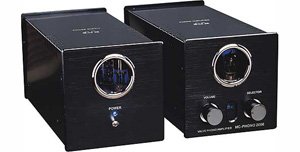
My current ‘stage of choice is a Trichord Dino with a Never Connected PSU (£750 together – the NCPSU is a huge upgrade from the standard power supplies, it turns a mid-fi component into a genuine audophile item, in my opinion). Previously I have owned a Loricraft Missing Link (£400), WhestTWO (£600), Melos PS-1 valve phonostage (£ummm, not sure – probably about £1000), Angle Audio “Audiophile” battery powered ‘stage (£150) … among others.
I’ve not used a phonostage as expensive as the Ming Da in my system before, so I can’t really judge its relative merit against its price peers, but I can say that the usual laws of diminishing return do not appear to apply in this case when compared to my excellent Dino/NCPSU at around half the price.
In brief, the MC-Phono2006 was superb; jaw-droppingly good. If I had £1600 to spend on a phonostage at the moment, Jack would have made a sale there & then!
The soundstage is just huge – but not bloomy or vague, it’s beautifully focussed and oh so natural, it’s like being there with the performers. As soon as the music started a feeling of wonderful rightness engulfed me – blimey, I didn’t realise my Pioneer PL-71 turntable could sound anywhere near this good!
You can tick off all the “audio virtues” you can think of for yourself. Bass, treble, dynamics blah-de-blah – it’s got them all. It’s just so much better than any other phonostage I have heard. Can it get better than this? Well, yes, of course it can, I guess …. but I can well imagine this being the ultimate destination for many LP lovers.
Yup, a rave review. I’d love to own one!
Although bear in mind it’s twice the price of other phonostages I have in-depth experience of, so comparative listening is recommended … unless you are as awestruck by its performance as I was, in which case just buy it!
Ming Da MC805A Monoblock Power Amps
Priced at £3499 a pair, these amps are designed around the visually impressive 1930’s 805ASE triode valve; each amp produces an output power of 40 watts in single ended mode. Ming Da’s own, high-current capacity ‘EI’ configured output transformer is used; these are hand-wound in-house, using Japanese steel laminations. The 805 power valve is driven by a directly coupled classic 6P3/6L6 beam tetrode running in class A, in turn driven by 6N8, 6N9 triodes.
Not huge, but quite heavy and very nicely formed, these amps look superb with the brightly lit 805 valve shining forth!
They are not an ideal match with my MBL speakers; whilst the speakers are an easy load to drive, at 83dB/W sensitivity the Ming Da’s 40W isn’t enough to let them reach their full dynamic capability – although the power meter at the front of each amp never headed into the red region.
Unlike the previous two Ming Da components, these power amps failed to excite me. They didn’t do anything particularly wrong, as such, but resolution across the frequency band wasn’t particularly great – everything was a little vague and smeared compared to how I know it can sound. Dynamic speed was a bit slowed, things were a little smoothed over. Deep bass was rolled off a bit and lacked a full sense of impact and definition. Treble was sweet but not that highly resolved.
‘Pleasant’ might be my 1WR (One Word Review) on these amps. Some folks like ‘pleasant’ and wouldn’t regard the term as pejorative, but it is not a sound that would put these amps on my personal ‘want list’.
Maybe it’s my speakers not being a good match for the 40W on offer from the Ming Da amps? But to be honest I don’t think so. I’ve happily used amps with as little as 10WPC with my MBLs and been very pleased with the sound.
Summary
For me, the MC805A power amps don’t provide a distinctive level of performance and at the price, and considerably below, there are many power amps I would rather listen to.
The MC Phono2006 phonostage and MC-7SE pre-amp, though, get a strong recommendation from me for their great sound and great value.
Author – Jerry
Review system: MBL 116F speakers, Parasound Halo A21 power amp, Krell KRC-3 pre-amp, Resolution Audio CD50 CD player, Arcam DV29 multiformat player, Pioneer PL-71 turntable/Zu-Denon 103 mc cartridge/Trichord Dino-NCPSU phonostage
Want to read more hifi reviews?



















































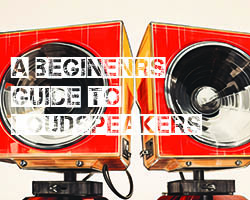































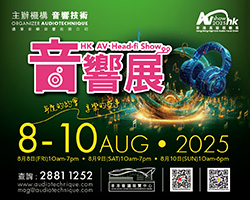









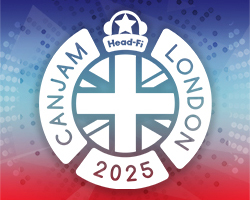







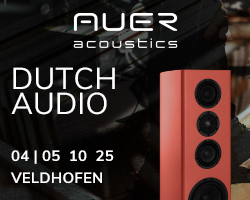




























































































You must be logged in to leave a reply.